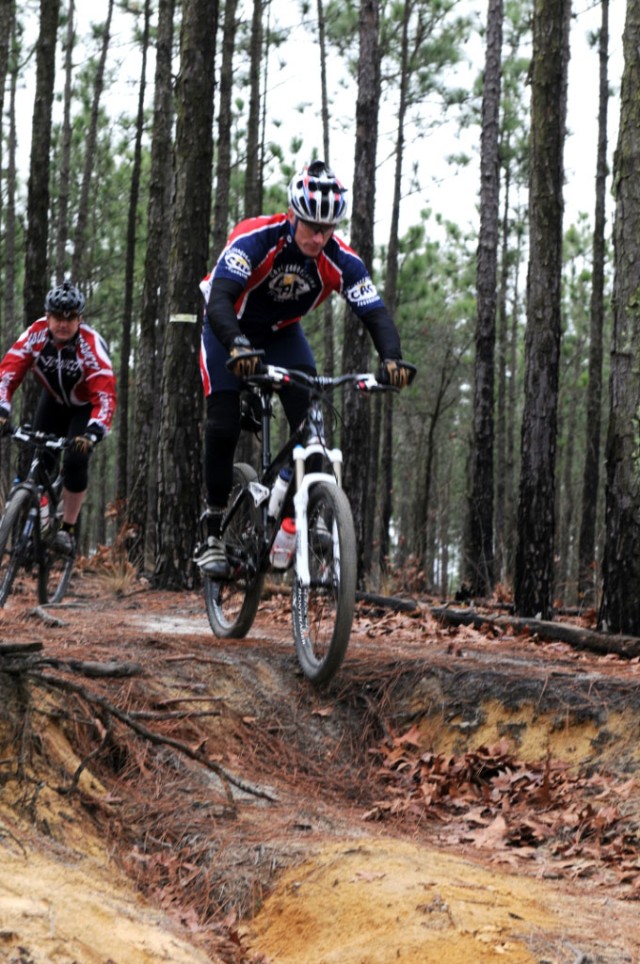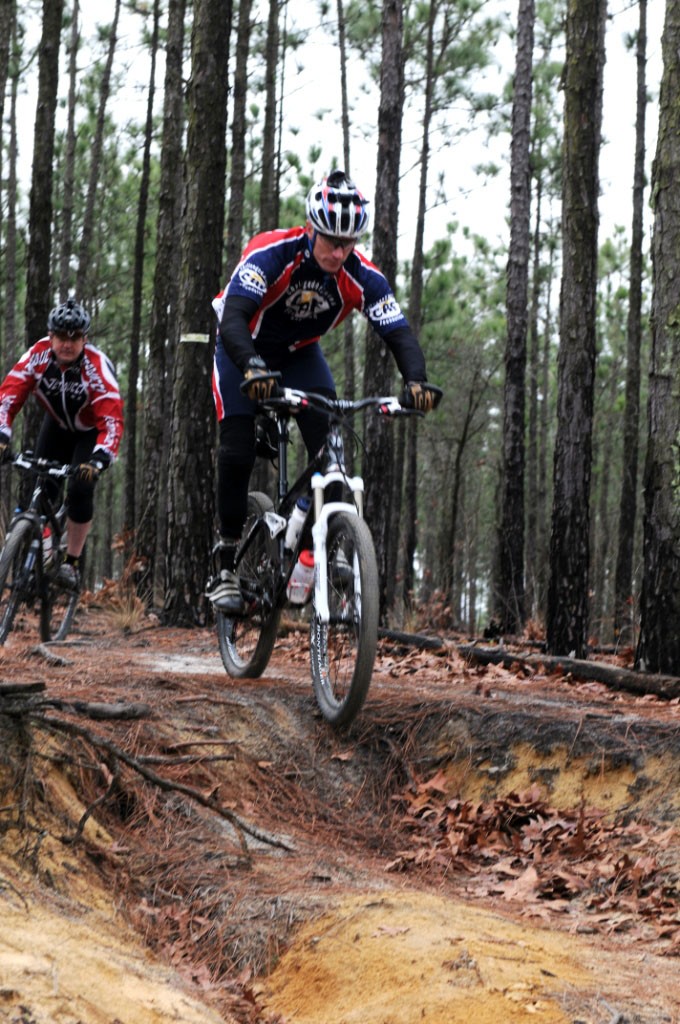
FORT BRAGG, N.C. - For Majs. Kent Solheim and Will Cotty the plan was simple - continue the mission.
After training for nearly a year for the annual Pisgah 36 adventure race, which is held near Asheville, N.C., Solheim and Cotty were ready to take on the event, which in the past was known as, "The Most Horrible Thing Ever."
But it was not to be, as a winter storm dumped several inches of snow on the location, causing officials to postpone the event for three months.
Because of prior military obligations and the anticipation of competition, the men came up with another plan - continue the mission, but in another event.
The next event, called the 12 Hours of Santos, was a mountain bike course that was built into a rock quarry. According to Solheim, the course, which was called the Vortex, proved to be an interesting challenge.
"Its rolling hills were the worst that it gets," explained Solheim, who works as the executive officer of 4th Battalion, 1st Special Warfare Training Group. "It was challenging, but a ton of fun."
He and Cotty ride to support the Special Operations Warrior Foundation, which benefits Family members of Special Operations warriors, who were either killed or wounded in the line of duty.
"The Special Operations Warrior Foundation's primary focus is children of Gold Star Families," Solheim said. "These are the Family members of Soldiers who were killed in combat or training-related accidents. The SOWF provides full college scholarships for these Family members to ensure that they're able to continue their education."
For Soldiers who are injured in combat, the organization provides benefits for their Families as well.
The SOWF will give $2,000 to the wounded warrior to offset the cost of Family travel after they receive notification of the injuries and are required to travel to a hospital in a different location, said Solheim.
He said the money helps during what can be a really turbulent time for the Family.
"I had two friends killed in separate incidents and both had two kids," Solheim explained. "The kids are automatically enrolled to receive full-ride scholarships, even if its 10 or 15 years from now, those children will have that. It's important for the community to know that someone will do that for them."
The fact that Solheim and Cotty compete in numerous adventure races for charity is quite a feat, but what is even more impressive is the fact that Solheim has remained competitive, despite having his right leg amputated because of wounds suffered in combat.
While serving in Karbala, Iraq, Solheim was shot four times. After more than a dozen surgical procedures to help him gain full use of his right leg failed, he made the difficult decision to have the leg amputated.
Solheim pointed out that the decision was not an easy one, but he had noticed other Soldiers who had prosthetic limbs and saw the progress that they were making, despite their injuries.
Solheim said he found strength in their courage and decided that he could do the same.
"I looked at guys who were three months, six months or a year ahead of where I was at that point," Solheim said in an interview with a U.S. Army John F. Kennedy Special Warfare Center and School reporter. "They were my inspiration to get out of bed and get back on track. Within a month, I was back out competing in the Boston Marathon with a hand-crank bike."
Cotty's story is similar in that he has restricted use of his legs after having knee replacement surgery shortly after Solheim's surgery. The two met during their unit's organization day and they began comparing notes.
Cotty said Solheim's courage inspired him and prompted him to become involved with the sport of mountain biking.
"When I saw Kent riding with his leg, I wanted to talk to him about his story," explained Cotty, who works as the operations officer of 1st Battalion, 1st SWTG.
"We both happened to be at organization day and he saw that I had a prosthetic and we had a conversation and I told him, 'if you find an endurance race, we'll do it' and that's exactly what he did," Solheim recalled.
Solheim, who's often been called Captain America, by most who have seen him compete in the endurance races, said it's important to remember that it's all about the Special Operations Warrior Foundation and not so much about his achievements.
He said he hopes to inspire other wounded warriors, just as he was inspired by those before him.
"It's not about me," the Oregon City, Ore. native explained in a previous interview. "It's about that guy who just got hurt and is now thinking, 'what now' I hope that I can help him know that it's going to be okay, that they can continue to live a normal life. There is hope."
As for the 12 Hours of Santos, Cotty said he thought it would be a little easier than the Pisgah 36, which stands for 36 hours, but features more than 70 miles of bike trails that climb more than 12,000 feet per day.
Although the 12 Hours of Santos was shorter, it was not any easier, according to Cotty.
"We figured it should be a bit easier, being that it was only 12 hours and not 36," said Cotty, a Columbia, S.C. native, in a previous interview. "I was wrong. It was without a doubt, the hardest thing I could have imagined. By the end of my sixth lap, I couldn't feel my hands anymore."
Regardless of how their bodies felt throughout the race, the men continued until their
mission was complete.
Solheim said he and Cotty are already looking ahead to what they hope will be their next event - a half Ironman event in Rhode Island in July. In addition, he said he hopes he can continue to inspire others in the process.
"The big story is the organization," Solheim said. "When you first get hurt, your life gets flipped upside down. For me it was motivation seeing others who were ahead of me. Maybe I can inspire someone the same way that I've been inspired. Not only from contributions to the force, but through my actions."
Anyone who wants to contribute to the Special Operations Warrior Foundation may do so by logging on to www.firstgiving.com/kentsolheim.

Social Sharing